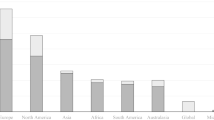Abstract
Effective conservation programs require data on both biodiversity and resource use. The rapid loss of biologically diverse areas adds urgency to the task. This study tests a forest valuation technique that provides essential data in a very short time on local resource use that can serve as a foundation for integrated conservation and development programming. This rapid interview method was tested by comparison with an intensive six-month technique. The data analyzed included the number of plant and animal species used and the calculated value in dollars per hectare per year ($/ha/yr) of different forest types for 67 families in three communities in the northern Peruvian Amazon. While the rapid ethnobiological method gave an accurate list of the most widely used species, accurate data on the quantities collected of these species and their relative values were substantially different from those in the long-term study. At present, the rapid survey is recommended only when necessary to provide data on the most useful species in order to prevent imminent forest destruction. We urge continued study of rapid methods to improve the accuracy of this potentially important conservation tool.
Similar content being viewed by others
Literature Cited
Alverson, W. S., L. O. Rodriguez, and D. K. Muskovits. 2001. Perú: Biabo Cordillera Azul. Rapid Biological Inventories: Report 2. The Field Museum of Chicago, Chicago.
Bernard, H. R. 2002. Research methods in anthropology: Qualitative and quantitative approaches. Alta Mira Press, Walnut Creek, CA, USA.
Borgatti, S. P. 1996. Anthropac 4. Analytic Technologies, Natick, MA.
Emmons, L. H., and F. Feer. 1997. Neotropical rainforest mammals. The University of Chicago Press, Chicago.
Fleisher, M. S., and J. A. Harrington. 1998. Freelisting: Management at a women’s federal prison camp. Pages 69–83 in V.C. de Munck and E. J. Sobo, eds., Using methods in the field: A practical introduction and casebook. Alta Mira Press, Walnut Creek, CA, USA.
Gavin, M. C. 2002. An assessment of forest use value in the northern Peruvian Amazon. Ph.D. dissertation, University of Connecticut, Storrs, CT.
Gentry, A. H. 1988. Changes in plant community diversity and floristic composition on environmental and geographical gradients. Annals of Missouri Botanical Garden 75(1):1–34.
Godoy, R., R. Lubowski, and A. Markandya. 1993. A method for the economic valuation of non-timber tropical forest products. Economic Botany 47(3): 220–233.
—,D. Wilkie, H. Overman, A. Cubas, G. Cubas, J. Demmer, K. McSweeny, and N. Brokaw. 2000. Valuation of consumption and sale of forest goods from a Central American rain forest. Nature 406:62–63.
Gove, S. and G. H. Pelto. 1994. Focused ethnographic studies in the WHO program for the control of active respiratory infections. Medical Anthropology 15(4):409–424.
Gram, S. 2001. Economic valuation of special forest products: an assessment of methodological shortcomings. Ecological Economics 36:109–117.
Guariguata, M. R. and R. Ostertag. 2001. Neotropical secondary forest succession: Changes in structural and functional characteristics. Forest Ecology and Management 148:185–206.
Handwerker, W. P. 2001. Quick ethnography. Altamira Press, Walnut Creek, CA, USA.
Hellier, A., A. C. Newton, and S. O. Gaona. 1999. Use of indigenous knowledge for rapidly assessing trends in biodiversity: A case study from Chiapas. Biodiversity and Conservation 8(7):869–889.
Hilty, S. L. and W. L. Brown. 1986. Birds of Colombia. Princeton University Press, Princeton, NJ.
Leesberg, J. and E. V. Chavez. 1994. The Juego de Registro. Pages 179–190 in H. S. Feldstein and J. Jiggins, eds., Tools for the field: Methodologies handbook for gender analysis in agriculture. Kumarian Press, West Hartford, CT.
Melville, B. 1993. Rapid rural appraisal—its role in health planning in developing countries. Tropical Doctor 23(2):55–58.
Melynk, M. and J. N. B. Bell. 1996. The direct-use values of tropical moist forest foods: The Huottuja (Piaroa) Amerindians of Venezuela. Ambio 25(7): 468–472.
Parker, T. A. and J. L. Carr. 1992. Status of forest remnants in the Cordillera de la Costa and adjacent areas of Southwestern Ecuador. RAP Working Paper #2. Conservation International, Washington, D.C.
Phillips, O. and A. H. Gentry. 1993. The useful plants of Tambopata, Peru: I. Statistical hypotheses tests with a new quantitative technique. Economic Botany 47(1): 15–32.
Prance, G. T., W. Balée, B. M. Boom, and R. L. Carneiro. 1987. Quantitative ethnobotany and the case for conservation in Amazonia. Conservation Biology l(4):296–310.
Roos, G. 1998 Pile sorting: “Kids like candy.” Pages 97–109 in V. de Munck and E. J. Sobo, eds., Using methods in the field: A practical introduction and casebook. Alta Mira Press, Walnut Creek, CA, USA.
Sudman, S. and N. Schwarz. 1989. Contributions of cognitive psychology to advertising research. Journal of Advertising Research 29:43–53.
Uturini, A., A. Winkvist, and G. H. Pelto. 2001. Appraising studies in health using rapid assessment procedures (RAP): Eleven critical criteria. Human Organization 60(4):390–400.
van der Marwe, D., G. E. Swan, and C. J. Botha. 2001. Use of ethnoveterinary medicinal plants in cattle by Setswana-speaking people in the Madikwe area of the Northwest Province of South Africa. Journal of the South African Veterinary Association 72(4):189–196.
Author information
Authors and Affiliations
Corresponding author
Rights and permissions
About this article
Cite this article
Gavin, M.C., Anderson, G.J. Testing a rapid quantitative ethnobiological technique: First steps towards developing a critical conservation tool. Econ Bot 59, 112–121 (2005). https://doi.org/10.1663/0013-0001(2005)059[0112:TARQET]2.0.CO;2
Received:
Accepted:
Issue Date:
DOI: https://doi.org/10.1663/0013-0001(2005)059[0112:TARQET]2.0.CO;2




